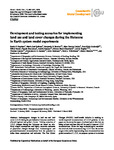Development and testing scenarios for implementing land use and land cover changes during the Holocene in Earth system model experiments
| dc.contributor.author | Harrison, SP | en |
| dc.contributor.author | Gaillard, M-J | en |
| dc.contributor.author | Stocker, BD | en |
| dc.contributor.author | Vander Linden, M | en |
| dc.contributor.author | Klein Goldewijk, K | en |
| dc.contributor.author | Boles, O | en |
| dc.contributor.author | Braconnot, P | en |
| dc.contributor.author | Dawson, A | en |
| dc.contributor.author | Fluet-Chouinard, E | en |
| dc.contributor.author | Kaplan, JO | en |
| dc.contributor.author | Kastner, T | en |
| dc.contributor.author | Pausata, FSR | en |
| dc.contributor.author | Robinson, E | en |
| dc.contributor.author | Whitehouse, NJ | en |
| dc.contributor.author | Madella, M | en |
| dc.contributor.author | Morrison, KD | en |
| dc.date.accessioned | 2021-09-20T12:43:51Z | |
| dc.date.available | 2021-09-20T12:43:51Z | |
| dc.date.issued | 2020-03-02 | en |
| dc.identifier.issn | 1991-959X | en |
| dc.identifier.uri | http://hdl.handle.net/10026.1/17864 | |
| dc.description.abstract |
Anthropogenic changes in land use and land cover (LULC) during the pre-industrial Holocene could have affected regional and global climate. Existing scenarios of LULC changes during the Holocene are based on relatively simple assumptions and highly uncertain estimates of population changes through time. Archaeological and palaeoenvironmental reconstructions have the potential to refine these assumptions and estimates. The Past Global Changes (PAGES) LandCover6k initiative is working towards improved reconstructions of LULC globally. In this paper, we document the types of archaeological data that are being collated and how they will be used to improve LULC reconstructions. Given the large methodological uncertainties involved, both in reconstructing LULC from the archaeological data and in implementing these reconstructions into global scenarios of LULC, we propose a protocol to evaluate the revised scenarios using independent pollen-based reconstructions of land cover and climate. Further evaluation of the revised scenarios involves carbon cycle model simulations to determine whether the LULC reconstructions are consistent with constraints provided by ice core records of CO2 evolution and modern-day LULC. Finally, the protocol outlines how the improved LULC reconstructions will be used in palaeoclimate simulations in the Palaeoclimate Modelling Intercomparison Project to quantify the magnitude of anthropogenic impacts on climate through time and ultimately to improve the realism of Holocene climate simulations. | en |
| dc.format.extent | 805 - 824 | en |
| dc.language | en | en |
| dc.language.iso | en | en |
| dc.publisher | European Geosciences Union | en |
| dc.title | Development and testing scenarios for implementing land use and land cover changes during the Holocene in Earth system model experiments | en |
| dc.type | Journal Article | |
| plymouth.issue | 2 | en |
| plymouth.volume | 13 | en |
| plymouth.journal | Geoscientific Model Development | en |
| dc.identifier.doi | 10.5194/gmd-13-805-2020 | en |
| plymouth.organisational-group | /Plymouth | |
| plymouth.organisational-group | /Plymouth/Faculty of Science and Engineering | |
| plymouth.organisational-group | /Plymouth/REF 2021 Researchers by UoA | |
| plymouth.organisational-group | /Plymouth/REF 2021 Researchers by UoA/UoA14 Geography and Environmental Studies | |
| dcterms.dateAccepted | 2020-01-20 | en |
| dc.rights.embargodate | 2021-09-21 | en |
| dc.identifier.eissn | 1991-9603 | en |
| dc.rights.embargoperiod | Not known | en |
| rioxxterms.versionofrecord | 10.5194/gmd-13-805-2020 | en |
| rioxxterms.licenseref.uri | http://www.rioxx.net/licenses/all-rights-reserved | en |
| rioxxterms.licenseref.startdate | 2020-03-02 | en |
| rioxxterms.type | Journal Article/Review | en |


